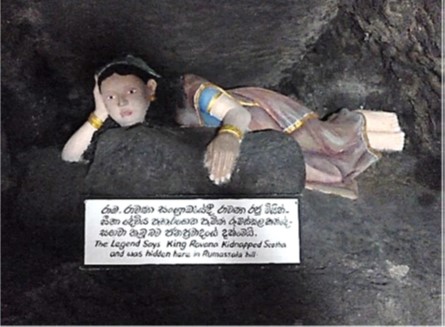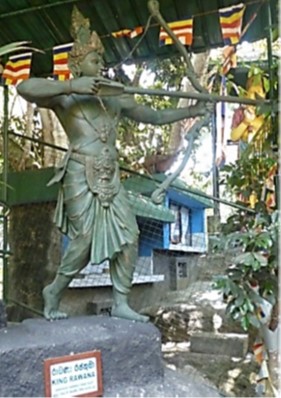BUDDHIST VIHARAS AND EELAM Part 22d
Posted on July 20th, 2024
KAMALIKA PIERIS
This essay looks at some of the sites where Ravana shrines have been set up. Most are in little known Buddhist sites, but there is one in Sigiriya.
Most people have accepted the Mahavamsa perception of Sigiriya as Kasyapa’s rock fortress said researcher Deborah de Koning. But having read Mirando Obeyesekere and Gananath Obeyesekere, Koning found that in the 1980s there were others who said that Sigiriya was created by Ravana or his half-brother Kuvera. Then after the war ended in 2009, several persons with an interest in Ravana started to publicly say that Sigiriya was Ravana’s palace. They spoke of Ravana’s Palace currently called Sigiriya Rock. This makes Sigiriya a contested site” between Ravana and Kasyapa, said Koning.
Ravana rituals were regularly conducted at Bolthumbe and Katuwana. At Bolthumbe there is a large Saman Devalaya, located on a hill. Next to the Saman devalaya a small Pattini shrine. A Ravana shrine is located in the backyard of the site.
The Ravana shrine at this Buddhist site seems a recent construction said Koning. At the entrance to the stand several signboards. One is about the history of Ravana (Ravanaithihasaya). The place is a historical kingdom of the glorious heroic sakvithi King Ravana who ruled Sri Lanka around 5,000 years ago. The signboard also carries the phone number of the Hela Ravana Padanama.
The Ravana statue at Katuwana is located on semi-private property. The statue is kept in a glass box inside a cave that is locked with a door. The cave has to be entered on bare feet, indicating the ‘sacredness’ of the cave as a shrine, and a cobra allegedly protects the cave. One has to climb down rocks to find the cave. Since 2016 or 2017, an annual Ravana perahera has been organized in Katuwana, said Koning.
There is a Ravana shrine in Dolosbage. The shrine was built around 2000 and later assigned to Ravana. The shrine is closed to the villagers. The area is a yaksha area, said the person in charge speaking to Koning. He told Koning that he considers himself a member of the Ravana generation, and explained that his family name, Pathirana, is derived from Kuvera pathi Ravana.
Weekly rituals are conducted in Dolosbage on Sundays. They start the preparations on Saturday evenings and chant to the Buddha. On Sunday mornings, they wake up at 3:00 a.m. and chant several mantras. They then take out the statues, which include those of Vishnu, Kataragama, and Paththini and anoint them (nanumura). They also bring out the jewellery of Ravana. The jewellery is anointed once a year and villagers are allowed to touch the jewellery then.
There is a Ravana shrine in Galge in Dondra as well. Members of the Ravana Shakthi went there perform a surya namaskar. Deborah de Koning, engaging in participant observation, went with them.
A day in April, close to the Sinhala New Year was selected as the sun would be at its highest point then. They found a local monk willing to participate in their ritual. Exactly at sunrise, they all changed their clothes, and clad in white, lined up by a tree to perform the sun salutation. The Hela worshipped the sun, and this site was one of the places where the ancient Hela practiced this ritual, they told Koning.
While the chanting was going on, we all stood around the tree and kept part of a thread in our hands that had been connected to the tree . After the chanting finished the monk tied the thread around our wrists and chanted over it. One of the men then placed a yashti (wooden stick) against our foreheads. The yashti was made of special wood that easily absorbed the solar power and transferred this energy when placed against the forehead, said Koning.
There is a Buddhist site at the Sri Vivekaramaya Viharaya in Rumassala. . Several statues of Ramayana characters are found at the Vivekaramaya Viharaya. The ‘Sita cave’ is a dark and extremely small cave that contains a statue of a reclining Sita. Outside the small cave, in addition to Hanuman, there is a bronze life-size statue of Ravana in a warrior position, adorned with jewellery and holding a bow and arrow.
The statues of Sita, Hanuman, and Ravana seem to be placed at the site not to arouse devotion but for tourist purposes. They are not enshrined and it is difficult to get close to them. The Buddhist site itself dates back to the 1970s but that the statues of the Ramayana related characters came later concluded Koning. ( Continued)

